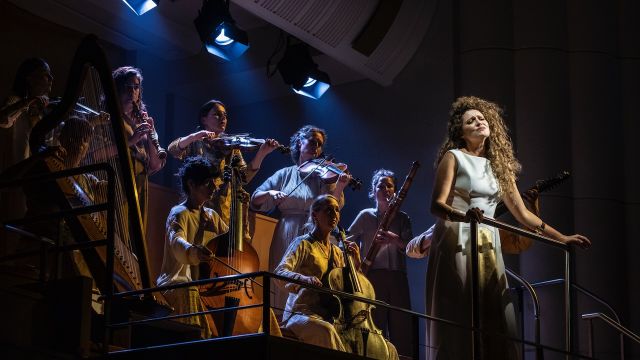Julius Caesar
A golden translucent pyramid adorned the stage, crowning the orchestra like a cake cover, which was appropriate for the ravishing music feast they provided, that perfectly balanced singing and players.
When Handel penned the opera, Castrati were all the rage, but even with his tools intact, the counter-tenor lead Tim Mead had a falsetto that was crystal clear. The melodies and vibrato floated out of him like an energetic bubble machine.

The cast walked into the Recital Hall through the audience in stylish modern Italian costumes and miliary uniforms. There was no set to speak of and the barest of minimum props.
Instead, Director Neil Armfield signalled the shifts in the epic narrative that included a triumphant march in Egypt, an exotic palace, campsites, grand battles, adventures both at sea and in the desert with small theatrical gestures, lighting and shadows.

At times the orchestra became glamorous participants in the story. A violinist climbed out of the pyramid to play impishly with Caesar in a mesmerising solo.
Brass players with what looked like period horns gathered in circle seats above the stage to perform dramatic flourishes.
A striking duet was between Caesar and a brass player for the aria ‘Silently and stealthily goes the shrewd hunter when he is hungry for game.’
The story is on the gruesome side. In the first act an Egyptian King arrives bearing the severed head of a slain enemy. The victim’s wife Cornelia (Stephanie Dillon) and son Sesto (Helen Sherman) bear witness to this – and even Caesar is disgusted.
It’s a trigger for the appearance in the second act of one of the rare props in the production, a knife which Sesto thrusts around dramatically in the aria ‘The injured serpent never sleeps.’
But the violence is so over the top that it is never menacing and at times cause for mirth.

There is also some romance. Cleopatra (Samantha Clarke) in disguise seduces Caesar in a delicious dance and aria coloured in by players around her.
More menacing is threat of sexual abuse – portrayed by striking countertenor Hugh Cutting. A highlight was when he contrasted his natural lower voice with his falsetto.
Be warned that this is a long opera. The fashion of the time was to repeat lyrics over and over again.

But the baroque flourishes of the orchestra, infectious performances and beautiful singing make the endurance well worthwhile.
David Spicer and Shirley Politzer
Photographer: Brett Boardman
Subscribe to our E-Newsletter, buy our latest print edition or find a Performing Arts book at Book Nook.

